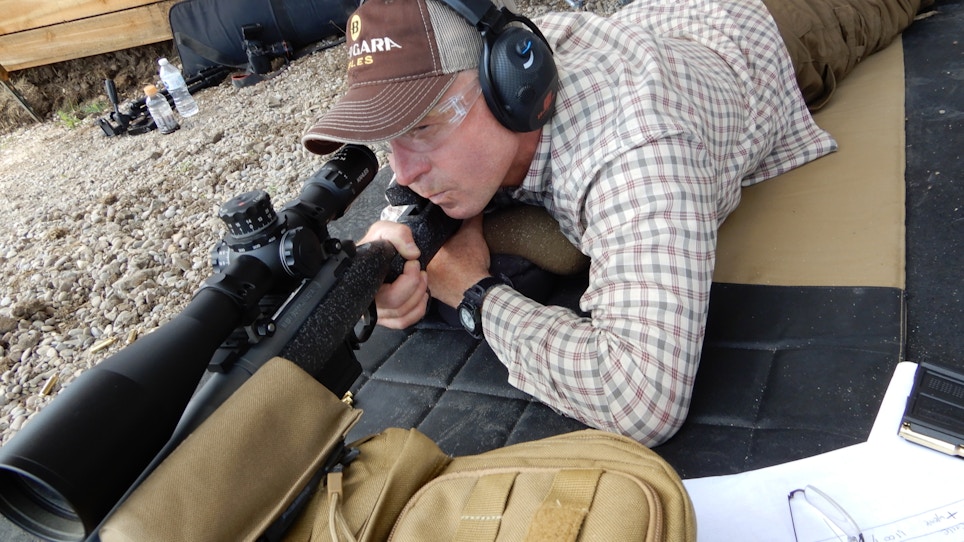
Putting in your time at the shooting range to learn your rifle, optics and abilities can pay off with more success in the field. Try different ammunition to see which works best with your rifle. (Photo: Mark Kayser)
Moses isn’t coming down from the Mount with a 10 Commandments for you to follow for coyote success this fur season. Despite that downer there are some guidelines you should take to heart when you finally do meet up with a coyote.
Follow these guidelines when those piercing eyes bound over a rise for your own spiritual experience in coyote country.
Know Your Shooting Limitations
Remove the hair from a coyote and you’ll see you’re aiming at a small target, approximately 5 inches in diameter. Add an inch if you’re hunting one of those burly, Northeastern brutes.
Your range time should reveal your accuracy to hit this sized target at distances you’ll experience in the country you hunt. Don’t forget about the changes bulky, winter clothing can add to your sight alignment, the surprise sendoff you might get pulling the trigger with frozen fingers and of course God’s gift of gusty winds that can misguide your bullet.
These and other factors can make a 300-yard chip shot at the range seem like a 1,000-yard challenge in the real world. And even though your conscience might tell you to take an extreme shot at a distant coyote speck in your reticle, every time you miss you sign another coyote diploma.
Know Your Shooting Gallery
Shooting well works only if you’re ready for the shot and it occurs well before you press the distress button on your caller.
After getting comfortably settled in an advantageous vantage point spend a few extra moments and either mentally map your area for all possible encounters, or even better yet, sketch the ground before you with pen and paper. That’s called making a range card in the military, and you should include pre-ranging all possible rises, low spots or openings you expect your first, best shot to present itself.
Of course, with coyotes, be sure to reconnoiter every possible downwind gallery as that’s where any smart coyote will maneuver. As a final prep, make sure you can swing your firearm easily to cover all of these lanes, check the stability of your firearm on shooting sticks and have every tool within easy reach — this includes a binocular, rangefinder, calls and a Snickers bar if it’s going to be a long set.
Shoot the First, Best Opportunity
It’s human nature to wait for a better deal, but while you’re watching a coyote race to your setup follow it visually and send one when you feel your first burst of confidence.
I was reminded of that a few weeks back as a coyote plowed through snow on its way to my calls and then never reappeared from a series of gullies below me. I should have shot it at 300 yards instead of waiting for Amazon Prime deal at close range.
To increase shot success, stop the coyote. Bark at it, use a decoy, even start some bird chatter to pique its curiosity. Moving targets increase your odds of missing, enough said.
Doubles? Take the Best Shot
If two coyotes show up, again, shoot at the first good opportunity. It’s not at all uncommon to call in multiple coyotes, and with the February breeding season upon us a pair could show up.
Personally, I stick to credo number three and take the first, best shot. Why? Coyotes in my zip code are cagey from hunting pressure, both nimrods and aerial gunning by pros. When a pair arrives I always pick the easy shot first because it’s too easy for a coyote to dive into a coulee never to be seen again. Flip back to the previous commandment for disappearing coyote notes. After dumping the first dog I’ll transition to a distressed coyote call and hope the second gives me a peekaboo moment. My coyote dog may also help in holding the second coyote for another holy Hornady event.
Professional coyote chaser Gary Roberson of Burnham Brothers Calls and host of Carnivore TV has a different take he shared with me.
“If I am calling by myself I like to shoot the back one first and for a couple of reasons,” he said. “Most likely the back coyote is a female and I know that from shooting lots of coyotes over the years. The lead coyote is likely the male so when he runs off after the shot there’s a higher chance of calling him back with a distressed coyote call. If you shoot the male first the female cuts and runs almost all of the time.”
Unlike the real 10 Commandments, these coyote commandments are simply guidelines. But as the fur season begins to wane they could help you with one last divine event in coyote country.





